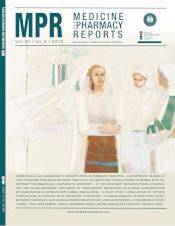Bruising as the first sign of exocrine pancreatic insufficiency
DOI:
https://doi.org/10.15386/mpr-1231Keywords:
bruising, vitamin K deficiency, steatorrhea, malabsorption, exocrine pancreatic insufficiencyAbstract
Exocrine pancreatic insufficiency is an important cause of chronic malnutrition, secondary to maldigestion-malabsorption, which can be caused in children especially by cystic fibrosis, but also by other much rarer diseases. The case of a 6 months and 3 weeks old male pediatric patient is reported, who was admitted to the clinic for head and forearms bruising. Laboratory findings identified vitamin K deficiency as the cause of the cutaneous hemorrhagic syndrome. Further investigations revealed association of steatorrhea (which is a marker of fat malabsorption), iron-deficiency anemia and hypovitaminosis D, which had been produced by nutritional deficiencies caused by malabsorption syndrome. From the numerous disorders that could be associated with pancreatic insufficiency in children, the following conditions had been excluded: cystic fibrosis (mucoviscidosis), cow`s milk protein intolerance, gluten-sensitive enteropathy (coeliac disease), Shwachman-Diamond syndrome, abetalipoproteinemia, etc. Based upon decreased levels of stool pancreatic elastase in repeated measurements, together with low serum lipase, the final diagnosis of exocrine pancreatic insufficiency was established. Treatment of this case consisted mainly in pancreatic enzyme replacement therapy, but also oral iron supplementation and dietary supplements with fat-soluble vitamins (A, D, E, K). The outcome was favorable, characterized by normalization of intestinal passage, ascending growth curve and normalization of the majority of laboratory tests values that were modified between the time of patient admission to our clinic and initiation of specific therapy (serum level of vitamin K, vitamin D and lipase, coagulation profile, hemoglobin and red blood cell indexes), as well as higher value of fecal pancreatic elastase.
Downloads
Published
How to Cite
Issue
Section
License
The authors are required to transfer the copyright of the published paper to the journal. This is done by agreeing to sign the Copyright Assignment Form. Whenever the case, authors are also required to send permissions to reproduce material (such as illustrations) from the copyright holder.

The papers published in the journal are licensed under a Creative Commons Attribution-NonCommercial-NoDerivatives 4.0 International License.

